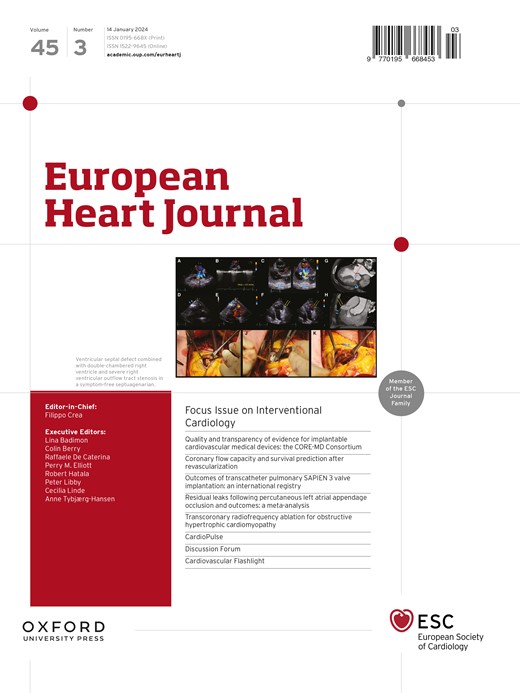从单个超声心动图视频片段检测心脏淀粉样变:一种新的基于人工智能的筛查工具。
IF 35.6
1区 医学
Q1 CARDIAC & CARDIOVASCULAR SYSTEMS
引用次数: 0
摘要
背景和目的利用当前的临床和超声心动图技术,准确区分心肌淀粉样变性(CA)和表型模拟仍然具有挑战性。评估了一种新的基于超声心动图的CA检测人工智能(AI)筛选算法的准确性。方法利用多地点、多民族数据集(n = 2612, 52% CA),训练卷积神经网络,利用经胸根尖四腔视频片段区分CA与表型对照。外部验证在全球18个站点进行,包括597例CA病例和2122例对照。在整个外部验证数据集上评估分类准确性,并对焦磷酸锝扫描转诊患者和年龄、性别和壁厚匹配的个体进行亚组分析。模型准确性也与转甲状腺素CA评分和壁厚增加的老年心力衰竭患者中保留射血分数和壁厚增加的评分进行了比较。结果心肌淀粉样变患者和对照组表现出相似的年龄、性别、种族和合并症。在去除不确定的AI预测(13%)后,无论CA亚型(敏感性:轻链型= 84%,野生型转甲状腺素= 85%,遗传性转甲状腺素= 86%),整个外部验证数据集的模型识别和分类都非常出色[受试者工作特征曲线下面积(AUROC) 0.93,灵敏度85%,特异性93%]。在亚组分析中,临床转诊的焦磷酸锝闪烁显像患者(AUROC 0.86,敏感性77%,特异性86%)和匹配的患者(AUROC 0.92,敏感性84%,特异性91%)的表现保持不变。AI模型(AUROC 0.93)也优于转甲状腺素CA评分(AUROC 0.73)和壁厚增加(AUROC 0.80)评分。结论该AI筛选模型-仅使用心尖四室视图-可有效区分CA与其他原因引起的左室壁厚度增加。本文章由计算机程序翻译,如有差异,请以英文原文为准。
Cardiac amyloidosis detection from a single echocardiographic video clip: a novel artificial intelligence-based screening tool.
BACKGROUND AND AIMS
Accurate differentiation of cardiac amyloidosis (CA) from phenotypic mimics remains challenging using current clinical and echocardiographic techniques. The accuracy of a novel artificial intelligence (AI) screening algorithm for echocardiography-based CA detection was assessed.
METHODS
Utilizing a multisite, multiethnic dataset (n = 2612, 52% CA), a convolutional neural network was trained to differentiate CA from phenotypic controls using transthoracic apical four-chamber video clips. External validation was conducted globally across 18 sites including 597 CA cases and 2122 controls. Classification accuracy was assessed on the entire external validation dataset, and subgroup analyses were performed both on technetium pyrophosphate scintigraphy referrals, and individuals matched for age, sex, and wall thickness. Model accuracy was also compared with the transthyretin CA score and the increased wall thickness score within a subset of older heart failure with preserved ejection fraction patients with increased wall thickness.
RESULTS
Cardiac amyloidosis patients and controls displayed similar age, sex, race, and comorbidities. After the removal of uncertain AI predictions (13%), model discrimination and classification were excellent for the entire external validation dataset [area under the receiver operating characteristic curve (AUROC) 0.93, sensitivity 85%, specificity 93%], irrespective of CA subtype (sensitivity: light-chain = 84%, wild-type transthyretin = 85%, and hereditary transthyretin = 86%). Performance was maintained in subgroup analysis in patients clinically referred for technetium pyrophosphate scintigraphy imaging (AUROC 0.86, sensitivity 77%, specificity 86%) and matched patients (AUROC 0.92, sensitivity 84%, specificity 91%). The AI model (AUROC 0.93) also outperformed transthyretin CA score (AUROC 0.73) and increased wall thickness (AUROC 0.80) scores.
CONCLUSIONS
This AI screening model-using only an apical four-chamber view-effectively differentiated CA from other causes of increased left ventricular wall thickness.
求助全文
通过发布文献求助,成功后即可免费获取论文全文。
去求助
来源期刊

European Heart Journal
医学-心血管系统
CiteScore
39.30
自引率
6.90%
发文量
3942
审稿时长
1 months
期刊介绍:
The European Heart Journal is a renowned international journal that focuses on cardiovascular medicine. It is published weekly and is the official journal of the European Society of Cardiology. This peer-reviewed journal is committed to publishing high-quality clinical and scientific material pertaining to all aspects of cardiovascular medicine. It covers a diverse range of topics including research findings, technical evaluations, and reviews. Moreover, the journal serves as a platform for the exchange of information and discussions on various aspects of cardiovascular medicine, including educational matters.
In addition to original papers on cardiovascular medicine and surgery, the European Heart Journal also presents reviews, clinical perspectives, ESC Guidelines, and editorial articles that highlight recent advancements in cardiology. Additionally, the journal actively encourages readers to share their thoughts and opinions through correspondence.
 求助内容:
求助内容: 应助结果提醒方式:
应助结果提醒方式:


